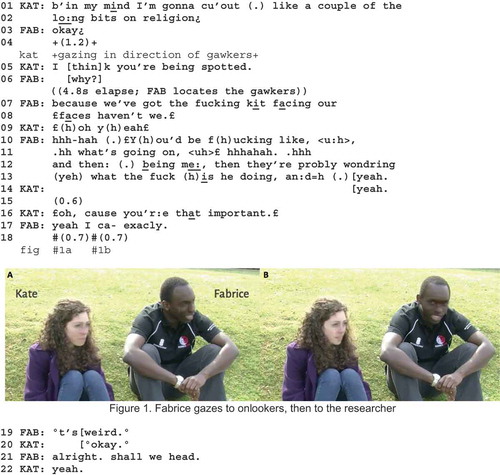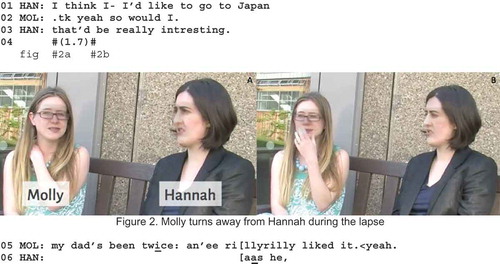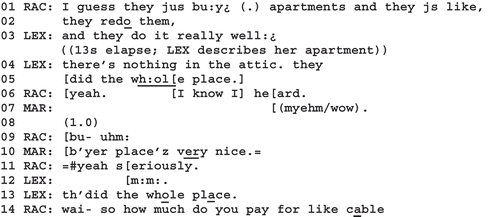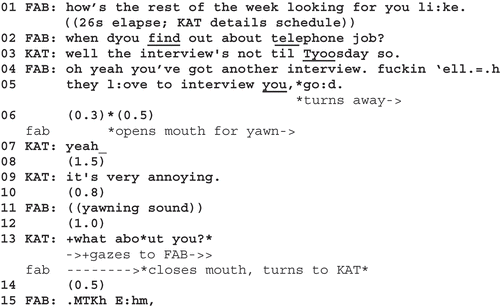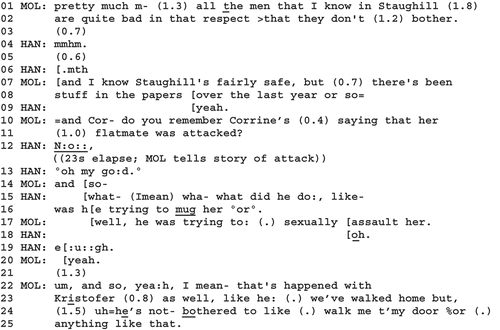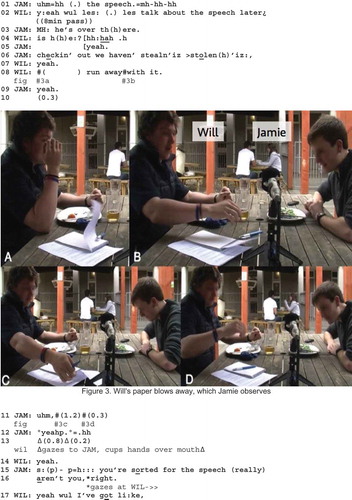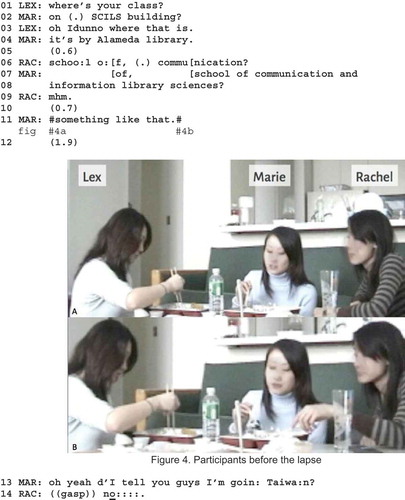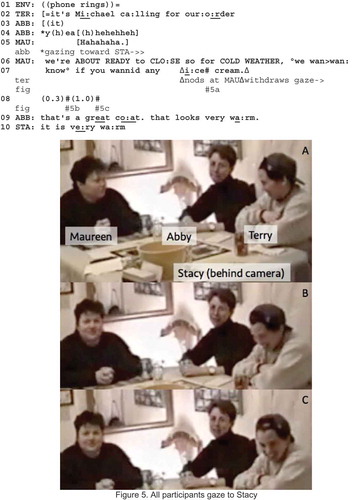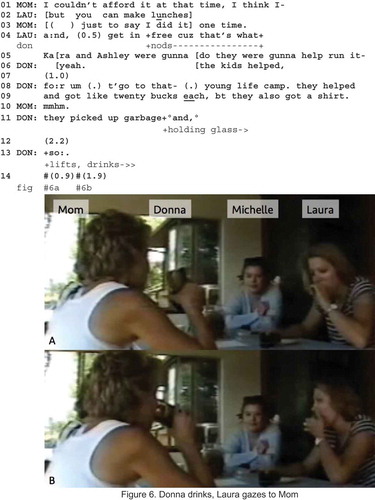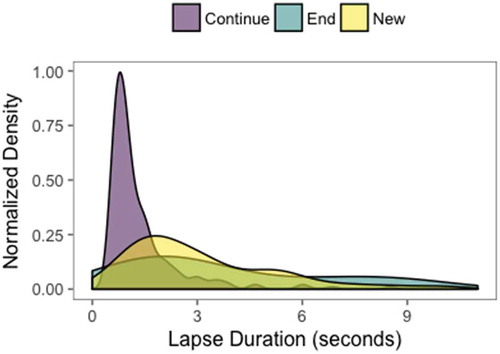ABSTRACT
How do conversational participants continue with turn-by-turn talk after a momentary lapse? If all participants forgo the option to speak at possible sequence completion, an extended silence may emerge that can indicate a lack of anything to talk about next. For the interaction to proceed recognizably as a conversation, the postlapse turn needs to implicate more talk. Using conversation analysis, I examine three practical alternatives regarding sequentially implicative postlapse turns: Participants may move to end the interaction, continue with some prior matter, or start something new. Participants are shown using resources grounded in the interaction’s overall structural organization, the materials from the interaction-so-far, the mentionables they bring to interaction, and the situated environment itself. Comparing these alternatives, there’s suggestive quantitative evidence for a preference for continuation. The analysis of lapse resolution shows lapses as places for the management of multiple possible courses of action. Data are in U.S. and UK English.
Much of social life occurs in situations where conversation is the central activity (Schegloff, Citation2006). For these situations, participants arrange themselves for sustained mutual involvement (Goffman, Citation1963; Kendon, Citation1990) and exchange speaking turns one after another with minimal gap and overlap (Sacks, Schegloff, & Jefferson, Citation1974). Any observer of such a scene could identify it as “a conversation.” It’s somewhat of an idealization, however, to picture these situations as uniformly consisting of continuous turn-by-turn talk. Certain contingencies might result in periods of extended silence. The conversation might be paused for participants to attend to another matter, it might get interrupted by an unexpected event, or—as I address in this article—it might lapse into silence for lack of a next speaker. The problem I am concerned with is how participants in ordinary conversations continue with talk-in-interaction after it lapses.
Lapses are periods of nontalk that develop when all interactants forgo the opportunity to self-select in a place where speaking was possible (Sacks et al., Citation1974). Some activities provide for lapses. For example, lapses that emerge during group coursework (Szymanski, Citation1999) or when watching television (Ergül, Citation2016) are accountable by reference to those activities. These situations have been characterized as “ongoing states of incipient talk” (Schegloff, Citation2007; Schegloff & Sacks, Citation1973) where even though participants aren’t engaged in continuous turn-by-turn talk, the pilot light of interaction is always on. These situations have also been examined as multiactivity settings (Haddington, Keisanen, Mondada, & Nevile, Citation2014) where lapses may be expected, allowed, or otherwise accounted for by reference to other concurrently relevant activities (Hoey, Citation2015).
This article focuses on settings where lapses are not as readily provided for, where there is nothing to “step in” and account for the silence. The central remit of activities like “catching up” and “cocktail chat” is the very act of conversing, without which the recognizability of such activities may be compromised. Participants in these conversational settings generally forgo alternative engagements that might otherwise account for a lapse, and so the emergence of a lapse may be understood as the conspicuous absence of talk (Hoey, Citation2015). This article addresses participants’ methods for resolving these conspicuous absences.
In conversational settings, lapses regularly appear in a specific structural location: sequence endings. A sequence is a series of linked turns through which participants collaboratively bring off courses of action (Schegloff, Citation2007). A sequence starts with some sequentially implicative action that provides for a determinate range of (conditionally) relevant next actions (Schegloff & Sacks, Citation1973), and in general, a sequence can be treated as complete when the conditions of whatever launched that sequence are met. This may transpire over just two paired actions (e.g., question-answer) but routinely transpires over a prolonged series of turns with the addition of preexpansions, insert expansions, and postexpansions (Schegloff, Citation2007). Because a sequence may be always expanded past a place of possible completion, sequence endings are always provisional. Participants’ methods for sequence closure may be seen as the inverse of those methods for sequence initiation. For proposing and enacting sequence closure, participants produce actions that are not sequentially implicative and do not provide for a range of next actions. Practices like minimal engagement in talk (Gardner, Citation2001; Jefferson, Citation1981), passing on the opportunity to speak (Schegloff, Citation1982), and proposing sequence completion (Schegloff, Citation2007) are regularly used to bring a sequence to possible completion.
Places of possible sequence completion systematically provide for lapses. By collectively treating the current sequence as adequately complete, participants not only furnish the space to move onto something else but also set the stage for “nothing” to come next. And if all participants refrain from self-selection in this environment, then a lapse emerges where turn transfer should have occurred. These lapses present a problem: For social occasions constituted by turn-by-turn talk, silence embodies the absence of a next speaker and, by implication, the absence of a next-thing-to-talk-about. The practical issue here is continuing with talk-in-interaction after a momentary lapse in conversation or, phrased technically, producing some sequentially implicative turn that would end the lapse in such a way that turn-by-turn talk resumes.
When conversation stalls, what comes next? This article describes sequentially implicative postlapse turns, or what speakers do after a lapse in conversation such that talk-in-interaction resumes. A systematically collected sample of 264 lapses revealed three practical alternatives for lapse resolution in ordinary talk. Participants may (a) move to end the interaction, (b) continue with prior talk, or (c) start something new. These cover a substantial range of orientations to the question of “what next?” in a lapse, though of course they do not exhaust the behaviors observed in lapse environments (e.g., disengagement (Goodwin, Citation1981) and sequence recompletion (Hoey, Citation2017)). In choosing from among these alternatives, participants reflexively display their understandings of where they are in the course of their interactions, exhibit sensitivity to the (in)completion of extant courses of action, and introduce as relevant something from “outside” the interaction, respectively.
Methods
The data are video recordings of ordinary conversations in UK/U.S. English between friends and intimates in homes and at university. The recordings featured mostly dyadic and triadic interaction, with occasional moments of four-party interaction. Participants provided informed consent for all recordings, and all identifying information has been anonymized in the transcripts. I systematically inspected 10 such recordings (about 3 hr) for lapses, which resulted in a collection of 264 cases.Footnote1
I classified silence as a lapse under three conditions. First, no speaker-selection technique (e.g., Hayashi, Citation2013) occurred in the just-prior talk or in the 500 ms of silence afterwards. I used 500 ms as an estimated lower limit for lapses because that is where the turn-taking option “same speaker continues” (Sacks et al., Citation1974) tends to cluster, as shown in Dutch (ten Bosch, Oostdijk, & Boves, Citation2005) and as suggested by the timing of other-initiated repair in English (Kendrick, Citation2015). Second, participants’ bodies remained in the same configuration as before the silence (Goffman, Citation1963; Goodwin, Citation1981; Mondada, Citation2009), thereby exhibiting a continuing commitment to conversation as the shared activity. And third, the silence contained no sequentially relevant embodied action (e.g., Arminen, Koskela, & Palukka, Citation2014; Keevallik, Citation2015). For example, a silence was excluded from the collection if there was a head nod response to the prior turn, as that embodied action formed a part of the course of action underway. By contrast, if the only movement seen during the silence was a participant lifting her drink, then that silence was included in the collection since her drinking was not analyzably part of any joint course of action.
The transcription conventions follow Jefferson (Citation2004) for verbal/vocal conduct and Mondada (Citation2014) for visible conduct. The data were analyzed using conversation analysis (e.g., Sidnell & Stivers, Citation2013).
Analysis
End the interaction
Lapses emerge when no one speaks, which implies that no one has anything else to say. These circumstances are naturally readable as implicating the end of the interaction. Ending an interaction is a collaborative matter (Schegloff & Sacks, Citation1973). Closings tend to begin with pre-closings, where coparticipants work out whether to end the interaction now. Then, if ending the interaction is warranted, they proceed to closings proper and ultimately conclude with a terminal exchange (e.g., bye-bye). Any movement to closure projects more talk because it makes conditionally relevant either alignment or resistance to closure. In this respect, initiating closings is one way that talk gets restarted. In my collection, participants moved to end the interaction after a lapse through things like invoking the time (e.g., don’t you have to leave soon?) and proposals to leave, like in Extract 1. Here, two friends (Kate and Fabrice) had been sitting and chatting in the grass on campus when they were approached unexpectedly by a researcher who asked to record their interaction. After setting up the camera, the researcher told them that he would wait in the distance and to “just wave” when they wanted to summon him to stop the recording.Footnote2 We join the interaction as Kate talks about an assignment for class (lines 1–2) but then spots some people in the distance who appear to be looking at them (line 4). Kate directs Fabrice’s attention to the gawkers, inviting speculation about why they’re being spotted (line 5; cf. registering in Extract 9, Sacks, Citation1992a, p. 81).
Extract 1 (RCE02_39)
Once they’ve located the onlookers, Fabrice supposes that it’s not him attracting their interest but the conspicuous recording equipment (lines 7–8)—an explanation that, through laughter and smile voice, Kate accepts with some chagrin (line 9). At this point, they’ve adequately accounted for the onlookers, and so the sequence is possibly complete. However, Fabrice continues the sequence by suggesting that their being looked at may have something to do with him (lines 10–13).Footnote3 Kate at first accepts this additional explanation (line 14), then after some silence,Footnote4 she produces a sarcastic remark (line 16). She targets the egocentricity of his last turn to mockingly undercut his self-praise. Fabrice goes along by ironically affiliating with her tease (line 17; Haugh, Citation2017), bringing the sequence to possible completion again, after which their talk lapses (line 18).
During the lapse, Fabrice turns in the direction of the researcher ()), which is a bodily orientation to ending the interaction. Both participants then end the lapse by starting in overlap. Fabrice gives a summary assessment of the situation (line 19), which is common in sequence closure (Schegloff, Citation2007), and Kate quietly utters okay (line 20), with which she displays preparedness to move onto some next-positioned matter (Beach, Citation1993). And so both have oriented to ending the interaction. Finally, Fabrice explicitly proposes departure, which Kate endorses (lines 21–22), after which they summon the researcher to end the interaction.
Participants may thus treat lapses as closure-implicative. This has an outcome of reengagement in talk because it makes relevant either alignment or resistance to ending the conversation (Schegloff & Sacks, Citation1973). In this respect, moving toward closings (whether or not it results in actual termination) constitutes one method for lapse resolution. It also demonstrates that lapses invite participants to situate themselves in the overall structural organization of their conversation—the beginning, somewhere in the middle, or the end—and prompts consideration of whether the interaction may conclude.
Continue with prior talk
Participants need not treat a lapse as closure-implicative but may continue the conversation after the lapse by using prior talk. This is the most common choice in my collection, constituting 80% (212/264) of the cases. The interaction-so-far provides a wealth of accumulated materials with which to construct a sequentially implicative utterance. Indeed, a fundamental mechanism underlying interactive language use is the reusage and reassembly of prior talk (e.g., Auer, Citation2015; Goodwin, Citation2013; Sacks, Citation1992a). In this subsection, speakers restart talk using resources from the interaction-so-far, including the current topic, the prelapse sequence, and some pre-prior sequence.
The current topic
The most common and straightforward way to continue with prior talk after a lapse is by “going on” with on-topic talk. There were 70 cases of this in my collection (26.5%). These typically took the form of minor topic shifts, which refresh the set of mentionable items (Maynard, Citation1980), as in Extract 2. Here, two friends (Molly and Hannah) are seated side by side on a bench, chatting about travel.
Extract 2 (RCE25_07)
Hannah announces that she’d like to go to Japan. Molly echoes that desire, which provides space for Hannah to expand on it. Rather than articulating, for instance, why she finds Japan alluring, Hannah provides a bland summary assessment of the idea (line 3). With this, nothing in particular is positioned to come next, which brings the sequence to possible completion. Neither participant self-selects afterwards, resulting in a lapse (line 4). During the lapse, Molly turns away ()), showing an understanding that no more talk is coming from Hannah (Rossano, Citation2012).
Molly ends the lapse by launching a telling about her father (line 5). This topic shift involves movement from the class “people who haven’t visited Japan” to its contrast class, “people who have visited Japan.” In this contrast class Molly locates her father and reports his evaluation of Japan. The topic shift also involves a semantic tie between “would like to go to X” and “been to X,” where the latter instantiates the desire of the former.Footnote5 Hannah stabilizes this topic shift by inviting Molly to expand (line 6), and turn-by-turn talk continues from there. Continuing with on-topic talk maintains continuity across a lapse, which may counteract the sense of disrupted topical flow. In this way, the topic of conversation furnishes materials for lapse resolution.
While prelapse and postlapse talk may be bound by topical means, they also share a discriminable sequential relationship (see Schegloff, Citation1990). Indeed, the tying procedures linking utterances together create sequential coherence in the first instance, and it is arguably this sequential coherence that provides for the recognizability of topical coherence (Sacks, Citation1992a, p. 541). For the remainder of this subsection, I focus on how participants exploit such sequential relationships for lapse resolution.
The prelapse sequence
The sequence immediately preceding the lapse furnishes the most accessible tools for resolving it. Two operations on the prelapse sequence are shown: initiation of a sequence-closing sequence and initiation of a reciprocal sequence. With sequence-closing sequences (Schegloff, Citation2007, p. 181) participants collaboratively finish some extended topic/sequence. Canonically, sequence-closing sequences begin with a proposal to close the topic/sequence at hand, typically through something that demonstrates an adequate grasp of whatever went before. Coparticipants may then either align or resist the proposal to end the sequence. Should the proposal be ratified, then a new sequence may be launched. This process may be occasioned by a lapse, as in Extract 3. Three friends (Lex, Marie, and Rachel) are having lunch at an apartment. We join the interaction as they discuss Lex’s landlords, who buy and remodel apartments to rent out (lines 1–3).
Extract 3 (GB07-7_09)
Lex describes how the landlords remodeled her place, ending her description with an extreme case formulation (Pomerantz, Citation1986) about how they redid the whole place (lines 4–5). Rachel receipts Lex’s description in overlap and treats it as old news (line 6). By showing herself as someone who already knew this information, Rachel diminishes the relevance of Lex saying more on the matter. And after Marie registers Lex’s description (line 7), their talk lapses into silence (line 8).
Marie ends the lapse by launching a sequence-closing sequence. She summarily assesses what went before, namely, that the landlords’ handiwork is evident in Lex’s very nice place (line 10). Rachel and Lex endorse Marie’s assessment (lines 11–12), thereby aligning with her movement to sequence closure. Lex—who might conceivably say more, given that it concerns her apartment—repeats her extreme case formulation (line 13). With her self-repeat, she indicates that she has no more to add, which permits movement away from the prelapse talk and onto something else. And indeed, what follows is Rachel initiating a new sequence (line 14). The practical utility of initiating a sequence-closing sequence after a lapse is that it projects more talk—either collaboration in or resistance to ending the sequence. This structurally resembles proposals to end the interaction (Schegloff & Sacks, Citation1973) but operates at the level of the sequence rather than the entire social episode.
Another operation on the prelapse sequence is the initiation of a reciprocal sequence, which involves redoing the prior sequence with reversed participatory roles (Schegloff, Citation2007, p. 195). Telephone openings (Schegloff, Citation1986) provide a classic example: One participant initiates a how-are-you sequence, and then once that sequence concludes, the other participant can initiate a reciprocal how-are-you sequence. Lapses provide a place for such reciprocal initiations, as in Extract 4 (same recording and participants as Extract 1). Fabrice initiates the first sequence—the one Kate reciprocates later on—by inquiring after Kate’s schedule for the week.
Extract 4 (RCE02_15)
After Kate details her schedule, their conversation turns to Kate’s job search. Fabrice solicits an update, but it turns out she doesn’t have one since the interview has yet to occur (lines 2–3). He receipts Kate’s answer with an oh yeah realization, after which he offers a commiserative assessment of Kate’s prolonged interview process while turning away (lines 4–5; Rossano, Citation2012). This brings the sequence to possible completion and leads to the development of a lapse (line 6). During this lapse, Kate produces two turns that recomplete the prior sequence (Hoey, Citation2017). She twice produces something that is directed toward the prior sequence but which does not implicate a next turn. She first produces a flat yeah (line 7), with which she acknowledges Fabrice’s assessment. Then after more silence, she expands on her agreement with an assessment (lines 8–9). Her assessment, like her yeah from before, recompletes the prior sequence; it extends that sequence with something that constitutes another possible ending of it. After even more silence,Footnote6 Kate resolves the lapse by initiating a reciprocal sequence (line 13). She asks what about you?, which is a linguistic construction practically dedicated to reprising the last sequence with reversed roles.
Lapses can thus occasion a kind of objectification of the prelapse sequence. Sequence endings are where participants decide whether to continue with the sequence or not—that is, where they reflect on the sequence, what was accomplished, its potential completion, its initiating conditions, and so forth. These considerations lend themselves to the use of sequence-closing sequences and reciprocal sequences. For if participants are in a position to reflect on whether the sequence is finished, then they can propose its closure, and if they’re considering whether the sequence’s initial conditions have been satisfied, then, for some sequence types, they may reciprocally reuse those initial conditions.
Some pre-prior sequence
In the following extracts, participants use materials not from the prelapse sequence but from before the prelapse sequence. Participants have numerous devices for continuing with sidetracked, diverted, or otherwise incomplete courses of action (e.g., Bolden, Citation2009; Mazeland & Huiskes, Citation2001). The following examples show that lapses are a place to use such devices. Extract 5 (same recording and participants as Extract 2) begins as Molly complains to Hannah about how men can be oblivious to the danger that women feel walking alone at night. As part of this complaint, Molly launches a story about the flatmate of their mutual acquaintance (lines 10–11).
Extract 5 (RCE25_27)
After Molly’s story concludes, Hannah responds with shock (line 13). Molly then projects some logical outgrowth of her story with and so but cuts off her turn once Hannah enters in overlap to target an unclear story detail (lines 14–15). This initiates a side sequence (Jefferson, Citation1972) in which clarifying the nature of the attack gets dealt with before going forward. Molly clarifies that the attack was sexual assault, which Hannah registers with a change-of-state token oh (Heritage, Citation1984) and a second reaction token (Wilkinson & Kitzinger, Citation2006) that’s hearable as a vocalized shudder (lines 17–19). Molly acknowledges Hannah’s revised understanding of the story, concluding the side sequence, after which a lapse develops (lines 20–21).
At this point, their storytelling activity is potentially complete—Molly’s story came to an adequate ending, after which Hannah gave an adequate response (Jefferson, Citation1978)—meaning they could take up some other matter, like a second story (Sacks, Citation1992b). What happens, though, is Molly continues with her complaint (lines 22–25). She recycles her and so, returning to the place where she cut off her turn, and produces an I-mean-prefaced utterance. This works to “[preserve] rather than [alter] the overall complaining course of action [she] is prosecuting” (Maynard, Citation2013, p. 205). Persisting with her complaint, Molly details a personal instance where Kristofer was insensitive to her fears about walking alone at night. In this way, Molly treats the lapse as a place to continue an incomplete course of action. Speakers in a lapse may thus treat prior courses of action as incomplete, which reflexively warrants their continuation.
Lapses may also provide for the resumption of deferred courses of action (see Bolden, Citation2009). In Extract 6, two friends (Will and Jamie) convened on campus to review a speech that Will wrote for class. Early in the recording, however, Will tables the task for later (lines 1–2). When we join the participants 8 min later, Jamie spots in the distance the researcher who had asked to record their interaction. They joke about the fact that the researcher had left expensive recording equipment with them (lines 3–9). Their joking activity comes to possible completion as they affirm each other’s understanding of the humor in their situation.
Extract 6 (RCE15A_0040)
As their joking activity winds down, Will’s notepad and pen are unsettled by some wind ()). Will promptly recollects his items, which Jamie observes with a glance ()). Will’s items are directly implicated in the postponed activity, so it’s possible that resuming that activity becomes relevant at this point. As Will gathers his items ()), Jamie projects a turn with uhm, pauses, and gazes to the notepad as Will returns his hands to resting position (line 11, )). Jamie’s fixation on the notepad indicates the continued relevance of the postponed activity. But rather than producing the turn he had projected, Jamie retracts his claim to the turn space with a soft yeahp, which is recognizably not a turn beginning (line 12). With no claimant to the turn space, a lapse emerges (line 13).
During the lapse, Will gazes to Jamie and cups his hands over his mouth. This bodily comportment indicates preparedness to be a recipient, and conversely, unpreparedness to speak. After a second of silence, Will ends the lapse with a muffled yeah (line 14). With this, he passes on the chance to produce a full turn-at-talk (Schegloff, Citation1982) and treats Jamie as the current speaker. Jamie restarts talk by asking whether Will is sorted for the speech (line 15). His question design (declarative syntax and two tag questions) strongly favors a yes answer (Heritage, Citation2010). This means that Will must resist the question’s constraints if he does in fact still need help, which turns out to be the case (line 17). A lapse may thus occasion the resumption of postponed tasks. In the absence of some definitive next thing to do, a deferred task presents itself as “something to do.”
In using some pre-prior course of action to restart talk after a lapse, speakers treat those materials as latently available. Lapses can occasion reflection on what’s happened in the interaction so far, and if there are “loose ends” then a lapse provides a place to tie them up. By using the prior talk to resolves a lapse, participants treat those matters as still open, available for use, and talk-about-able in some respect.
Start something new
As opposed to ending the interaction or continuing with prior talk, starting something new poses a different problem. For if a speaker decides against ending the interaction, they commit to going on with it in some way. And if they also decide against continuing with prior matters, then they forgo anchoring the turn in already-established grounds. So what do speakers use to start up from cold, as it were? In the following, speakers are shown using two resources for restarting talk: unmentioned mentionables and their situated environment.
Unmentioned mentionables
Before ending an interaction, participants routinely provide space for the introduction of unmentioned mentionables. These are matters that participants might want to talk about but which they were unable to fit into the natural flow of conversation (Button & Casey, Citation1985; Schegloff & Sacks, Citation1973). Lapses are another natural environment for unmentioned mentionables like complaints, updates, and, as shown in the following, announcements. This extract (same recording and participants as Extract 3) starts with two question-answer sequences about the location of Marie’s class, after which a lapse emerges (line 12). Both before the lapse starts and just as it begins, the participants are oriented to their food (–)).
Extract 7 (GB07-7_50)
Marie ends the lapse by announcing an upcoming trip (line 13). She prefaces it with oh yeah, which marks her forthcoming talk as “just realized” (Heritage, Citation1984) and adumbrates some self-attentive matter (Bolden, Citation2006). This indicates that her turn emerges not as an outgrowth of the prior talk but from her own set of unmentioned mentionables. Her announcement starts with d’I tell you guys, which projects some tellable and treats her recipients as “people who would care about this news.” Rachel responds by gasping and prompting expansion (line 15; Maynard, Citation1997), after which talk resumes. This shows that lapses can provide for matters that didn’t emerge organically in the development of interaction, and more generally, that they afford relatively drastic changes in topic and course of action.
The situated environment
Lapses may be resolved by registering some perceptible aspect of the situated environment. Any interaction’s material setting contains numerous objects, features, and events of potential relevance. Participants need only detect its relevance for the here-and-now interaction. One way that the “outside” gets into the interaction is through assessments, noticings (e.g., Goodwin & Goodwin, Citation2012; Sacks, Citation1992b; Schegloff, Citation2007), or, more broadly, registerings (Pillet-Shore, Citation2017a; Steensig, Baldauf-Quilliatre, Heinemann, & Grønkjær, Citation2015). Through a registering, a speaker transforms some previously unremarkable perceptible feature into something of potential interactional consequence. In Extract 8, Pat, Maureen, Abby, and Terry have sat down to play a board game at Pat and Terry’s home. The researcher making this recording, Stacy, has just finished setting up the recording equipment and is putting on her coat to leave. As she does so, the phone rings in the next room and Pat goes to answer it.
Extract 8 (GameNight_09)
Terry jokingly identifies the caller and a reason-for-the-call (line 2). Her coparticipants laugh appreciatingly, and Maureen advances Terry’s joke by simulating the caller (lines 4–7). Terry affirms Maureen’s joke with a nod then withdraws her gaze (line 7, )), bringing their joking to possible completion (Rossano, Citation2012). A lapse then emerges (line 8). During the lapse, Maureen and Terry turn to Stacy, who’s putting on her coat (–)). Their bodily dispositions create a new interactional space (Mondada, Citation2009) focused on Stacy. Abby uses this new embodied configuration to treat a previously irrelevant object as something of interactional consequence; she registers Stacy’s coat as being great (line 9). Participants ordinarily take into account whether some registered item is a possessed item, as in this case, where Stacy must now deal with being complimented (see Pomerantz, Citation1984). There’s also a temporal constraint, in that the coat would depart from accessibility once Stacy herself departed. So the noticeability of her coat partially depends on registering it now (e.g., Goodwin & Goodwin, Citation2012). Stacy affirms her postively valenced registering with an agreeing expanded clausal assessment (line 9; Thompson, Fox, & Couper-Kuhlen, Citation2015, p. 166), which results in the continuation of talk.
The utility of registerings for lapse resolution is that the set of registerable items is theoretically unbounded; almost anything can be imbued with interactional relevance. In Extract 9, Donna, Michelle, Laura, and Mom [Laura’s] are having snacks at home on the veranda. It begins with Mom giving an excuse for why she didn’t participate in an event last year. Laura and Donna counter Mom’s excuse by informing her that she could volunteer to gain entry to the event (lines 1–9).
Extract 9 (Farmhouse_0322)
Mom weakly receipts their suggestion with an mmhm continuer, after which Donna provides more detail about volunteering (lines 10–11). Donna’s turn concludes with a trail-off conjunction and, which exhibits her turn as being complete (Walker, Citation2012). In this environment, some reaction from Mom might be appropriate, like an evaluation of the informing. However, she forgoes self-selection, leading to the emergence of a lapse (line 12). During the lapse, Donna remains still while holding her glass, perhaps awaiting some talk from Mom. But after 2.2 s of silence, she lifts her glass while producing a stand-alone so (line 13, ); Raymond, Citation2004). With this, she indicates that she will neither add to the prior sequence nor initiate a new one. The option to self-select thus passes to her coparticipants. Laura gazes to Mom ()), orienting to the possibility that Mom might speak. However, the two meet each other’s gaze and exchange shrugs, effectively communicating that they each have nothing to add (lines 14–16). Michelle resolves the lapse by registering the environment as so nice and peaceful now (line 17), after which talk resumes.
What Michelle registers is the absence of commotion. The tranquility of their setting isn’t time sensitive like the coat of someone taking leave; it was presumably available since the start of their interaction. Nor is tranquility a material object that can be possessed or pointed to; it’s an absence that contrasts with some expected state. Participants can take something insubstantial like an absence and press it into interactional service. Speakers may thus treat lapses as occasions to probe their surroundings for something to talk about and impart meaning to a previously unremarkable thing through registerings (Schegloff, Citation2007, p. 82; Pillet-Shore, Citation2017a). These actions also bear implications for the lapse itself. For in registering something, the speaker retrospectively accounts for her activity during the lapse. So instead of self-selecting and speaking, which are the expected actions in this environment, she shows herself as having been actively probing/observing the environment.
A preference for continuation?
Given the three lapse resolution alternatives described previously, we might ask if there’s a preference for one over another. That is, is this particular sequential environment “built” to favor particular outcomes over others in the same way that, for instance, invitations are designed for receiving a yes (e.g., Pillet-Shore, 2017b)? Going by sheer ubiquity, my collection is biased toward some form of continuation (n = 212, 80%), with instances of starting something new (n = 45, 17%) and moving to end the interaction (n = 7, 3%) being much less common. This distribution suggests that continuing with something grounded in the prior talk is preferred over the other options. Another form of evidence for this possible preference is observed in lapse durations. provides counts of each lapse resolution type and descriptive statistics for the lapse durations before each type. visualizes these statistics in overlapping density plots.
Table 1. Count and lapse duration for each lapse resolution alternative.
Across all measures of lapse duration (mean, median, and mode), the choice to continue with prior talk takes less time than starting something new, which takes less time than moving to closings. That is, old things come faster than new things, which come a bit faster than endings. illustrates this relative ordering. The peak for Continue precedes the peaks for New and End. In contrast to the tight concentration of observations for Continue, those for New and End show greater variability. These results are consistent with the interpretation that speakers first attempt to resolve a lapse using something from prior talk, after which the floor is open to launch something new or initiate closings. Or conversely, would-be speakers hold off starting something new or ending the interaction until it’s clear that no continuation is forthcoming.
While these data give prima facie evidence for such a preference, they await further confirmation. To be confident that such a preference is real for participants, there would need to be more robust sampling, more cases of ending the interaction, and normative evidence showing participants’ understandings of the different lapse resolution alternatives (see Pillet-Shore, Citation2017b).
Discussion
For many social occasions, when conversation stalls participants face the question of what should come next. How speakers resolve this issue, and the things they use to do so, have been the focus of this article. I described three practical alternatives regarding the question “what next?” after a lapse. Speakers may treat the lapse (a) as closure-implicative by moving to end the interaction; (b) as a place to go on with something from their interaction-so-far; or (c) as a place to start a new course of action. These findings build on conversation analytic work on the basic structural organization of talk-in-interaction by focusing on the absence of talk in a specific sequential location. They extend prior work on lapses (Hoey, Citation2015, Citation2017) by showing how a silence generated by turn-taking practices (i.e., refraining from self-selection) is routinely dealt with in ways that resonate at the level of overall structural organization (Robinson, Citation2013).
Comparing the three alternatives, I presented evidence suggesting a preference for continuation over starting something new or ending the interaction. This bias toward continuation may simply reflect the typical length of an interaction’s structural phases; participants usually spend more time in middles rather than beginnings or endings. It may also reflect the principle of contiguity (Sacks, Citation1987), whereby participants work to fit their contributions into the sequential position at hand. It is perhaps easier to use what is already available in going forward given that its relevance and intelligibility have already been intersubjectively grounded. The prior talk offers more readily graspable and deployable resources than fashioning a sequentially implicative turn de novo. Additionally, by using the accumulated materials of the interaction-so-far, speakers resolve lapses such that their turn connects to something from before. This way, lapses are rendered as occurring within some course of action, rather than as irruptive silences. Maintaining contiguity across a lapse gets at Sacks’s (Citation1992b) assessment that “the measure of a good topic is a topic that not so much gets talked of at length, but that provides for transitions to other topics without specific markings of that a new topic is going to be done” (p. 352).
What emerges from these findings is a picture of lapses as junctures for the management of multiple possible courses of action. From a coarse-grain perspective, stopping, continuing, and starting are all directions to go after a lapse. In selecting one or another, participants reveal their understandings of where they’re situated with respect to current, past, and potential courses of action. Lapses in ordinary talk can prompt consideration of what has happened so far as it bears on what can or should happen next. They are silences that invite examination of the adequate completion of the current sequence, of previous courses of action, and of the interaction as a whole. They provide for the placement of things that otherwise might go unmentioned, and for the incorporation of “outside” elements into the interaction.
Additional information
Funding
Notes
1 Extracts 6 and 9 aren’t part of these 264 lapses and therefore were not used for the descriptive statistics in the analysis. These were selected for this article because they more clearly exhibited the phenomena under consideration than the instances in the collection of 264.
2 These same recording circumstances hold for Extracts 2, 4, 5, and 6.
3 Fabrice’s notoriety likely comes from his prominent position in student government (R. Ogden, personal communication, July 2017).
4 The silence in line 15 is a lapse but not the focal lapse in this extract. Nevertheless, my analysis of the postlapse turn in line 16 would resemble my analyses in the section “Continue with prior talk.”
5 I thank an anonymous reviewer for pointing out this connection.
6 Note that during this lapse Fabrice is observably yawning, which impedes his speaking ability. However, it’s possible that he orients to the relevance of talk during this lapse by producing the yawning vocalization in line 11.
References
- Arminen, I., Koskela, I., & Palukka, H. (2014). Multimodal production of second pair parts in air traffic control training. Journal of Pragmatics, 65, 46–62. doi:10.1016/j.pragma.2014.01.004
- Auer, P. (2015). The temporality of language in interaction: Projection and latency. In A. Deppermann & S. Günther (Eds.), Temporality in interaction (pp. 27–56). Amsterdam, The Netherlands: John Benjamins.
- Beach, W. A. (1993). Transitional regularities for ‘casual’ “Okay” usages. Journal of Pragmatics, 19(4), 325–352. doi:10.1016/0378-2166(93)90092-4
- Bolden, G. (2006). Little words that matter: Discourse markers ‘so’ and ‘oh’ and the doing of other-attentiveness in social interaction. Journal of Communication, 56(4), 661–688. doi:10.1111/j.1460-2466.2006.00314.x
- Bolden, G. (2009). Implementing delayed actions. In J. Sidnell (Ed.), Conversation analysis: Comparative perspectives (pp. 326–354). Cambridge, England: Cambridge University Press.
- Button, G., & Casey, N. (1985). Topic nomination and topic pursuit. Human Studies, 8, 3–55. doi:10.1007/BF00143022
- Ergül, H. (2016). Adjournments during TV watching: A closer look into the organisation of continuing states of incipient talk. Discourse Studies, 18(2), 144–164. doi:10.1177/1461445615623904
- Gardner, R. (2001). When listeners talk: Response tokens and listener stance. Amsterdam, The Netherlands: John Benjamins.
- Goffman, E. (1963). Behavior in public places: Notes on the social organization of gatherings. New York, NY: The Free Press.
- Goodwin, C. (1981). Conversational organization: Interaction between speakers and hearers. New York, NY: Academic Press.
- Goodwin, C. (2013). The co-operative, transformative organization of human action and knowledge. Journal of Pragmatics, 46(1), 8–23. doi:10.1016/j.pragma.2012.09.003
- Goodwin, M. H., & Goodwin, C. (2012). Car talk: Integrating texts, bodies, and changing landscapes. Semiotica, 191(1/4), 257–286.
- Haddington, P., Keisanen, T., Mondada, L., & Nevile, M. (Eds.). (2014). Beyond multitasking: Multiactivity in social interaction. Amsterdam, The Netherlands: John Benjamins.
- Haugh, M. (2017). Teasing. In S. Attardo (Ed.), Handbook of language and humor (pp. 204–218). London, England: Routledge.
- Hayashi, M. (2013). Turn allocation and turn sharing. In J. Sidnell & T. Stivers (Eds.), Handbook of conversation analysis (pp. 167–190). Oxford, England: Wiley-Blackwell.
- Heritage, J. (1984). A change-of-state token and aspects of its sequential placement. In J. M. Atkinson & J. Heritage (Eds.), Structures of social action: Studies in conversation analysis (pp. 299–345). Cambridge, England: Cambridge University Press.
- Heritage, J. (2010). Questioning in medicine. In A. F. Freed & S. Ehrlich (Eds.), ‘Why do you ask?’: The function of questions in institutional discourse (pp. 42–68). Oxford, England: Oxford University Press.
- Hoey, E. M. (2015). Lapses: How people arrive at, and deal with, discontinuities in talk. Research on Language and Social Interaction, 48(4), 430–453. doi:10.1080/08351813.2015.1090116
- Hoey, E. M. (2017). Sequence recompletion: A practice for lapse management. Journal of Pragmatics, 109, 47–63. doi:10.1016/j.pragma.2016.12.008
- Jefferson, G. (1972). Side sequences. In D. Sudnow (Ed.), Studies in social interaction (pp. 294–338). New York, NY: Free Press.
- Jefferson, G. (1978). Sequential aspects of storytelling in conversation. In J. Schenkein (Ed.), Studies in the organization of conversational interaction (pp. 219–248). New York, NY: Academic Press.
- Jefferson, G. (1981). ‘Caveat speaker’: A preliminary exploration of shift implicative recipiency in the articulation of topic. Final report to the (British) Social Science Research Council.
- Jefferson, G. (2004). Glossary of transcript symbols with an introduction. In G. H. Lerner (Ed.), Conversation analysis: Studies from the first generation (pp. 13–34). Amsterdam, The Netherlands: John Benjamins.
- Keevallik, L. (2015). Coordinating the temporalities of talk and dance. In A. Deppermann & S. Günthner (eds.), Temporality in Interaction (pp. 309–336). Amsterdam, The Netherlands: John Benjamins.
- Kendon, A. (1990). Conducting interaction: Patterns of behavior in focused encounters. Cambridge, England: Cambridge University Press.
- Kendrick, K. H. (2015). The intersection of turn-taking and repair: The timing of other-initiations of repair in conversation. Frontiers in Psychology, 6(250), 10–3389. doi:10.3389/fpsyg.2015.00010
- Maynard, D. W. (1980). Placement of topic changes in conversation. Semiotica, 30(3–4), 263–290. doi:10.1515/semi.1980.30.3-4.263
- Maynard, D. W. (1997). The news delivery sequence: Bad news and good news in conversational interaction. Research on Language and Social Interaction, 30(2), 93–130. doi:10.1207/s15327973rlsi3002_1
- Maynard, D. W. (2013). Defensive mechanisms: I-mean-prefaced utterances in complaint and other conversational sequences. In M. Hayashi, G. Raymond, & J. Sidnell (Eds.), Conversational repair and human understanding (pp. 198–233). Cambridge, England: Cambridge University Press.
- Mazeland, H., & Huiskes, M. (2001). Dutch ‘but’ as a sequential conjunction. In M. Selting & E. Couper-Kuhlen (Eds.), Studies in interactional linguistics (pp. 141–169). Amsterdam, The Netherlands: John Benjamins.
- Mondada, L. (2009). Emergent focused interactions in public places: A systematic analysis of the multimodal achievement of a common interactional space. Journal of Pragmatics, 41(10), 1977–1997. doi:10.1016/j.pragma.2008.09.019
- Mondada, L. (2014). Conventions for multimodal transcription. Retrieved from https://franz.unibas.ch/fileadmin/franz/user_upload/redaktion/Mondada_conv_multimodality.pdf
- Pillet-Shore, D. (2017a, July). Making the sensory social: Registering in copresent interaction. Paper presented at the 15th Conference of the International Pragmatics Association. Belfast, Northern, Ireland.
- Pillet-Shore, D. (2017b). Preference organization. In J. Nussbaum (Ed.), Oxford research encyclopedia of communication. New York, NY: Oxford University Press. doi:10.1093/acrefore/9780190228613.013.132
- Pomerantz, A. M. (1984). Agreeing and disagreeing with assessments: Some features of preferred/dispreferred turn shapes. In J. M. Atkinson & J. Heritage (Eds.), Structures of social action: Studies in conversation analysis (pp. 57–101). Cambridge, England: Cambridge University Press.
- Pomerantz, A. M. (1986). Extreme case formulations: A way of legitimizing claims. Human Studies, 9(2–3), 219–229. doi:10.1007/BF00148128
- Raymond, G. (2004). Prompting action: The stand-alone “so” in ordinary conversation. Research on Language and Social Interaction, 37(2), 185–218. doi:10.1207/s15327973rlsi3702_4
- Robinson, J. (2013). Overall structural organization. In J. Sidnell & T. Stivers (Eds.), Handbook of Conversation Analysis (pp. 257–280). Oxford, England: Wiley-Blackwell.
- Rossano, F. (2012). Gaze behavior in conversation. Unpublished PhD dissertation. Radboud University, Nijmegen, The Netherlands.
- Sacks, H. (1987). On the preferences for agreement and contiguity in sequences in conversation. In G. Button & J. R. E. Lee (Eds.), Talk and social organisation (pp. 54–69). Clevedon, England: Multilingual Matters.
- Sacks, H. (1992a). Lectures on conversation (Vol. 1). Oxford, England: Blackwell.
- Sacks, H. (1992b). Lectures on conversation (Vol. 2). Oxford, England: Blackwell.
- Sacks, H., Schegloff, E. A., & Jefferson, G. (1974). A simplest systematics for the organization of turn-taking in conversation. Language, 50(4), 696–735. doi:10.1353/lan.1974.0010
- Schegloff, E. A. (1982). Discourse as an interactional achievement: Some use of “uh-huh” and other things that come between sentences. Georgetown University Round Table on Languages and Linguistics, Analyzing Discourse: Text and Talk, 71–93.
- Schegloff, E. A. (1986). The routine as achievement. Human Studies, 9(2–3), 111–151. doi:10.1007/BF00148124
- Schegloff, E. A. (1990). Sequence as a source of coherence in conversation. In B. Dorval (Ed.), Conversational organization and its development (pp. 111–151). Norwood, NJ: Ablex Publishing.
- Schegloff, E. A. (2006). Interaction: The infrastructure for social institutions, the natural ecological niche for language, and the arena in which culture is enacted. In N. J. Enfield & S. C. Levinson (Eds.), Roots of human sociality: Culture, cognition, and interaction (pp. 70–96). Oxford, England: Berg.
- Schegloff, E. A. (2007). Sequence organization in interaction: A primer in conversation analysis. Cambridge, England: Cambridge University Press.
- Schegloff, E. A., & Sacks, H. (1973). Opening up closings. Semiotica, 8, 289–327. doi:10.1515/semi.1973.8.4.289
- Sidnell, J., & Stivers, T. (Eds.). (2013). The handbook of conversation analysis. Oxford, England: Wiley-Blackwell.
- Steensig, J., (chair), Baldauf-Quilliatre, H., Heinemann, T., & Grønkjær, C. (2015, August). Registering the material world. Panel conducted at the 2015 Conference of the International Institute of Ethnomethodology and Conversation Analysis. Kolding, Denmark.
- Szymanski, M. H. (1999). Re-engaging and dis-engaging talk in activity. Language in Society, 28(1), 1–23. doi:10.1017/S0047404599001013
- ten Bosch, L., Oostdijk, N., & Boves, L. (2005). On temporal aspects of turn taking in conversational dialogues. Speech Communication, 47(1), 80–86. doi:10.1016/j.specom.2005.05.009
- Thompson, S. A., Fox, B. A., & Couper-Kuhlen, E. (2015). Grammar in everyday talk: Building responsive actions. Cambridge, England: Cambridge University Press.
- Walker, G. (2012). Coordination and interpretation of vocal and visible resources: ‘Trail off’ conjunctions. Language and Speech, 55(1), 141–163. doi:10.1177/0023830911428858
- Wilkinson, S., & Kitzinger, C. (2006). Surprise as an interactional achievement: Reaction tokens in conversation. Social Psychology Quarterly, 69(2), 150–182. doi:10.1177/019027250606900203

